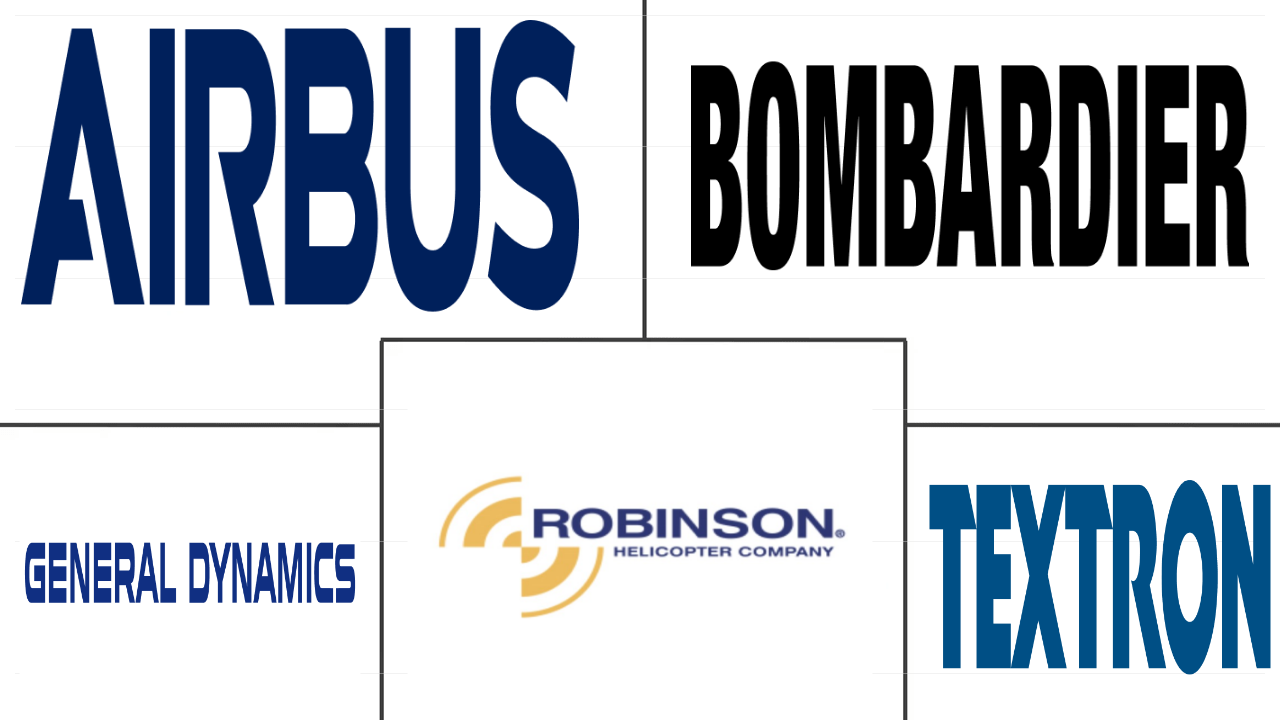Market Size of asia-pacific general aviation Industry
| Icons | Lable | Value |
|---|---|---|
|
|
Study Period | 2017 - 2030 |
|
|
Market Size (2024) | USD 2.92 Billion |
|
|
Market Size (2030) | USD 4.27 Billion |
|
|
Largest Share by Sub Aircraft Type | Business Jets |
|
|
CAGR (2024 - 2030) | 6.52 % |
|
|
Largest Share by Country | Australia |
|
|
Market Concentration | Medium |
Major Players |
||

|
||
|
*Disclaimer: Major Players sorted in no particular order |
Asia-Pacific General Aviation Market Analysis
The Asia-Pacific General Aviation Market size is estimated at 2.92 billion USD in 2024, and is expected to reach 4.27 billion USD by 2030, growing at a CAGR of 6.52% during the forecast period (2024-2030).
2.9 B
Market Size in 2024 (USD)
4.3 B
Market Size in 2030 (USD)
3390
Total Deliveries in the Historic Period (2017-2023)
3775
Total Deliveries during the Forecast Period (2024-2030)
Largest Market by Sub-Aircraft Type
54.90 %
value share, Business Jets, 2023
Frequent traveling requirements of HNWIs to attend business and private affairs and their lifestyle are encouraging them to acquire more expensive private planes.
Largest Market by Body Type
90.56 %
value share, Large Jet, 2023
Consumer preference for large jets across the region is driving the demand. Therefore, manufacturers offer a wide range of products to consumers according to their convenience.
Largest Market by Country
24.16 %
value share, Australia, 2023
The country's procurement of a large number of helicopters and business jets is anticipated to drive it to occupy a major share of the regional general aviation market.
Leading Market Player
23.57 %
market share, General Dynamics Corporation, 2022

Gulfstream Aerospace provides many general aviation aircraft across the region, making it a second-leading player.
Second Leading Market Player
11.85 %
market share, Airbus SE, 2022

The company's wide range of technologically innovative and advanced products and strong customer support network allow it to be a second-leading player.
The increasing number of high net-worth individuals (HNWIs) in the region and their preference for private jet and helicopter travel for personal or business purposes also contribute to the increased procurement of business jets and piston fixed-wing aircraft
- Asia-Pacific accounted for around 5% of the global business jet deliveries in 2022. Similarly, piston fixed-wing aircraft accounted for 10% of global deliveries in 2022.
- The rising number of HNWIs in the region and their preference for private jets and helicopters for personal or business travel are also helping boost the procurement of private jets in the general aviation sector. For instance, the HNWI population in the region increased from 8.77 million in 2017 to 13.9 million in 2022.
- The COVID-19 pandemic adversely impacted the general aviation sector in the Asia-Pacific region. Global restrictions on travel and pandemic-induced lockdown affected the demand in the general aviation sector. The deliveries of business jets declined by 27% in 2020 compared to 2019. Similarly, the deliveries of turboprop aircraft declined by 19%, and the helicopters category witnessed a fall of around 14%. However, with the ease of travel restrictions, there is an increasing momentum in the number of people traveling and adopting private jets.
- Bombardier was the leading OEM, with 24% of the current operational fleet size, followed by Gulfstream and Textron, with 21.2% and 20.3%, respectively, in the Asia-Pacific business jet fleet as of July 2022. In terms of current operational fleet size in the business jet category, large jets dominated with a fleet size of 565 aircraft, followed by light jets and mid-size jets with 364 and 133 aircraft, respectively. During 2023-2030, around 4,533 general aviation aircraft are expected to be delivered in the region.
China is expected to be the major market in the Asia-Pacific General Aviation Market
- . The reduced economic activities in Asia-Pacific, along with travel-related restrictions, affected the utilization and procurement of business jets, helicopters, and turboprop aircraft in the region.
- The rise of HNWIs and UHNWIs, who prefer private jets and helicopters for personal or business travel in Asia-Pacific, aided in the procurement of aircraft in the general aviation sector. From 2017 to 2022, the HNWI population in the region increased by 64%.
- In terms of the current operational fleet, China was the leading country with around 21% of the overall Asia-Pacific business jet fleet, followed by Australia, India, and Japan with around 18%, 13%, and 9% of the deliveries, respectively, as of July 2022. In the helicopter category, Australia was the leading country with around 32% of the overall helicopter fleet, followed by China, Japan, and New Zealand with around 18%, 12%, and 11% of the deliveries, respectively, as of July 2022.
- The overall aircraft deliveries in the general aviation sector were affected during the COVID-19 pandemic, and the growth between 2019 and 2021 was -7.8% The helicopter category was dominated by single-engine helicopters, which accounted for 70% of the current operational Asia-Pacific helicopter fleet. The large-scale utilization of single-engine helicopters in corporate aviation aided in the procurement of single-engine helicopters.
- Approximately 4100+ aircraft are expected to be delivered in in the region during 2023-2030 The economic recovery in the developing economies in the region, such as China and India, is expected to aid the growth of the general aviation sector in Asia-Pacific during the forecast period.
Asia-Pacific General Aviation Industry Segmentation
Business Jets, Piston Fixed-Wing Aircraft, Others are covered as segments by Sub Aircraft Type. Australia, China, India, Indonesia, Japan, Malaysia, Philippines, Singapore, South Korea, Thailand are covered as segments by Country.
- Asia-Pacific accounted for around 5% of the global business jet deliveries in 2022. Similarly, piston fixed-wing aircraft accounted for 10% of global deliveries in 2022.
- The rising number of HNWIs in the region and their preference for private jets and helicopters for personal or business travel are also helping boost the procurement of private jets in the general aviation sector. For instance, the HNWI population in the region increased from 8.77 million in 2017 to 13.9 million in 2022.
- The COVID-19 pandemic adversely impacted the general aviation sector in the Asia-Pacific region. Global restrictions on travel and pandemic-induced lockdown affected the demand in the general aviation sector. The deliveries of business jets declined by 27% in 2020 compared to 2019. Similarly, the deliveries of turboprop aircraft declined by 19%, and the helicopters category witnessed a fall of around 14%. However, with the ease of travel restrictions, there is an increasing momentum in the number of people traveling and adopting private jets.
- Bombardier was the leading OEM, with 24% of the current operational fleet size, followed by Gulfstream and Textron, with 21.2% and 20.3%, respectively, in the Asia-Pacific business jet fleet as of July 2022. In terms of current operational fleet size in the business jet category, large jets dominated with a fleet size of 565 aircraft, followed by light jets and mid-size jets with 364 and 133 aircraft, respectively. During 2023-2030, around 4,533 general aviation aircraft are expected to be delivered in the region.
| Sub Aircraft Type | |||||
| |||||
| Piston Fixed-Wing Aircraft | |||||
| Others |
| Country | |
| Australia | |
| China | |
| India | |
| Indonesia | |
| Japan | |
| Malaysia | |
| Philippines | |
| Singapore | |
| South Korea | |
| Thailand | |
| Rest of Asia-Pacific |
Asia-Pacific General Aviation Market Size Summary
The Asia-Pacific general aviation market is poised for significant growth, driven by an increasing number of high-net-worth individuals (HNWIs) who prefer private jets and helicopters for personal and business travel. This trend is bolstered by the region's rising wealth, with Asia-Pacific emerging as a leading destination for wealth management and private banking globally. Despite the initial setbacks caused by the COVID-19 pandemic, which led to a decline in aircraft deliveries, the market is recovering as travel restrictions ease and demand for private aviation rises. The region's economic recovery, particularly in developing economies like China and India, is expected to further fuel the growth of the general aviation sector.
The market is moderately consolidated, with major players such as Airbus SE, Bombardier Inc., General Dynamics Corporation, Robinson Helicopter Company Inc., and Textron Inc. holding significant shares. The Asia-Pacific region accounted for a notable portion of global business jet and piston fixed-wing aircraft deliveries, with China, Australia, India, and Japan leading in operational fleet sizes. The helicopter category is dominated by single-engine helicopters, widely used in corporate aviation. The market's growth is supported by strategic expansions and acquisitions by key companies, as evidenced by recent agreements and investments in aircraft and infrastructure.
Asia-Pacific General Aviation Market Size - Table of Contents
-
1. MARKET SEGMENTATION (includes market size in Value in USD and Volume, Forecasts up to 2030 and analysis of growth prospects)
-
1.1 Sub Aircraft Type
-
1.1.1 Business Jets
-
1.1.1.1 Large Jet
-
1.1.1.2 Light Jet
-
1.1.1.3 Mid-Size Jet
-
-
1.1.2 Piston Fixed-Wing Aircraft
-
1.1.3 Others
-
-
1.2 Country
-
1.2.1 Australia
-
1.2.2 China
-
1.2.3 India
-
1.2.4 Indonesia
-
1.2.5 Japan
-
1.2.6 Malaysia
-
1.2.7 Philippines
-
1.2.8 Singapore
-
1.2.9 South Korea
-
1.2.10 Thailand
-
1.2.11 Rest of Asia-Pacific
-
-
Asia-Pacific General Aviation Market Size FAQs
How big is the Asia-Pacific General Aviation Market?
The Asia-Pacific General Aviation Market size is expected to reach USD 2.92 billion in 2024 and grow at a CAGR of 6.52% to reach USD 4.27 billion by 2030.
What is the current Asia-Pacific General Aviation Market size?
In 2024, the Asia-Pacific General Aviation Market size is expected to reach USD 2.92 billion.

